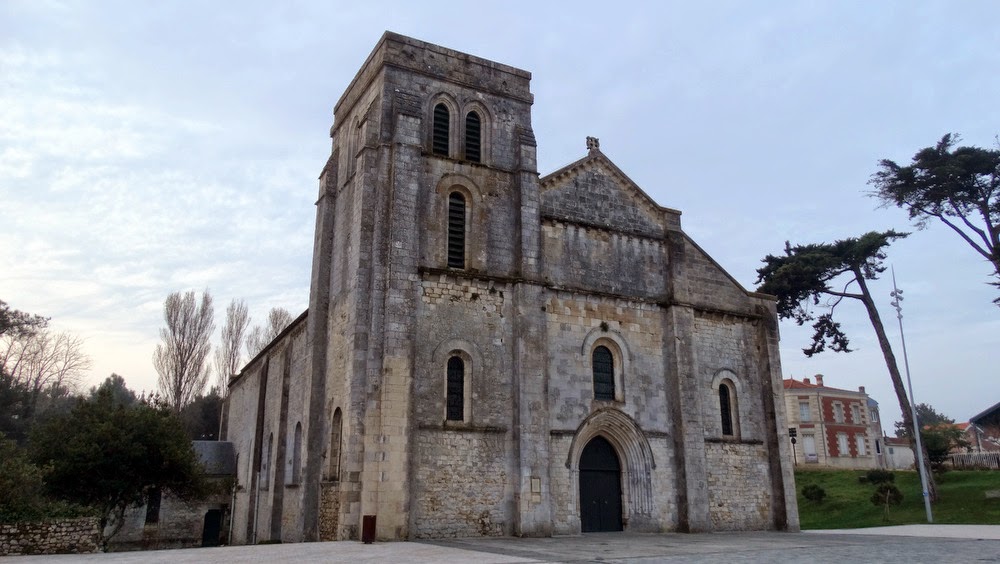During my recent early-morning trip to Soulac-sur-Mer, I made a point of staying put until sunrise to be able to visit a number of sights which I thought deserved coverage on the blog, and which show that there is much more to this Médocain seaside resort than its characteristic red-brick houses, and its doomed ocean-front residence Le Signal.
Some of the sights have direct ties with past blog subjects, such as this first landmark, one of the world’s many replicas of the Statue of Liberty. An explanatory text at the base of the statue explains that it was commissioned by the town in 1980 and manufactured by the Paris ateliers of Arthus-Bertrand, using the original mould designed by sculptor Auguste Bartholdi. However, an urban legend also suggests that the statue is the very one
which was located on Place Picard in Bordeaux from 1888 until its
disappearance at the hands of the Germans in 1941. Which version is
true?
Whatever, the statue has been positioned at a spot which is doubly significant: not only is the statue facing out towards its more illustrious counterpart in New York, but it is appropriately near to Pointe de Grave, the northern tip of the Médoc, which was where Marquis de La Fayette, en route from Pauillac on board the ship La Victoire in 1777, made a final stop before crossing the Atlantic and becoming a hero as general in the American Revolutionary War.
Moving slightly inland, this is Notre-Dame-de-la-fin-des-Terres basilica, which was originally built between the 12th and 15th centuries, but is possibly most associated with the 100 years or so it spent buried under sand, until a massive recovery operation was launched in 1869.
The recovery operation had been commissioned by the then Archbishop of Bordeaux, Cardinal Donnet, who we have already encountered on this website as the instigator of Sacré-Coeur parish church in Bordeaux and the man behind the installation of the bells in Pey-Berland tower. Donnet also ordered the construction of this next building, an abbey/monastery in the area where a monastery had previously stood from the 12th century onwards.
The work proved both difficult and costly, particularly the restoration of the upper structure (entablature) and roof of the old basilica. With more and more people visiting the site (and Soulac at large as the town's seaside resort reputation grew), the sand soil and dunes also needed to be stabilised. As previously recounted on the blog, funds needed to be found and were to come from an unusual source: the story goes that archive documents left by previous generations of monks included the secret formula for a mysterious “elixir” used for dental hygiene purposes. This was sold on to Bordeaux toothpaste manufacturer Seguin, who turned it into their flagship product. The abbey/monastery is now a works committee children’s holiday home.
Our next stop is this ornate (and currently disused) fountain, which is leading a quiet life on the middle of a roundabout in Soulac after many years spent on les Allées de Tourny in central Bordeaux.
The fountain is the work of Mathurin Moreau and comprises statues designed by Michel Joseph Napoléon Liénard. It was one of two such fountains to be positioned on the Allées in the 1850s, and both were removed – along with the Léon Gambetta monument – in the 1960s when the Allées de Tourny were given a radical overhaul (most notably to accommodate an underground car park). The other fountain has, since 2007, been positioned on a roundabout on Avenue Honoré-Mercier in Montreal, Canada, where it is known as “Fontaine de Tourny”.
Finishing up in the town centre, there are a number of interesting buildings to spot, such as those pictured here, starting with the indoor market, which is said to regularly be a hive of activity… although it
wasn’t when I was there, possibly because it was still a touch early in
the morning! Just outside, the services of a number of local trades are
advertised, along with depictions of some essential tourist sights, on an
unusual hand-painted ceramic tile feature. Below are the Soulac branches of banks Caisse d’Épargne and Crédit Agricole. Are the interiors as elegant as the façades?
There are many more stories to tell about this pleasant little town – and one or two may even be coming soon on the blog – but for now we’ll sign off by taking in some fresh ocean air and the most famous of Soulac’s sights: its Atlantic beach.
- Find them on the Invisible Bordeaux map:
- Statue of Liberty, Notre-Dame-de-la-fin-des-Terres, Soulac abbey/monastery, Fontaine de Tourny, Soulac-sur-Mer.

















Lovely article. Makes one want to go visit again.
ReplyDeleteThank you sir!
Delete